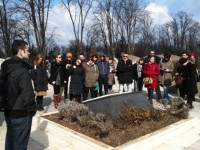Regional Study Visit to Sites of Memory - Serbia

Documenta – Centre for Dealing with the Past is organizing regional study visits to sites of memory, which include a series of three educational study visits in Croatia, Bosnia and Herzegovina, and Serbia to sites marked with traumatic events from the period 1941-1945. Our aim is to systematically learn about practices of marking sites of suffering and about the commemorative culture in the region, to initiate a public dialogue on the culture of remembrance, as well as to strengthen a team of experts interested in dealing with the past in particular countries.
In the period March 1 to 3, 2013, we have organized the second out of three planned regional study visits dedicated to the culture of remembrance, which was held in Serbia. During the study visit, we visited the following locations: camp 'Staro sajmište', cemetery of the liberators of Belgrade, Jewish cemetery, memorial-cemetery of the fighters of the national liberation struggle, location of the former camp Topovske šupe in Belgrade, as well as memorial-complex Sremski front near Adaševci.
Nenad Lajbenšperger from the Republican commission for the protection of cultural monuments in Belgrade gave us a presentation about Staro sajmište camp, which was established on 8 December 1941, under the jurisdiction of Gestapo for Serbia and command of the SS officers. Milan Radanović, associate on the 'Staro sajmište' project, guided us through the Jewish cemetery, memorial-cemetery of the fighters of the national liberation struggle and cemetery of the liberators of Belgrade, giving us a detailed account of the historical background of these sites, as well as on their current lives in the mental map of sites in Belgrade related to the city's anti-fascist past.
Except for the mentioned locations, we have also visited the exhibition "Yugoslavia from beginning until the end" in the Museum of Yugoslavia's History, where we were guided by Hrvoje Klasić, one of the authors of the exhibition texts, from the history department at the Faculty of Social Sciences, University of Zagreb. In the Museum of Yugoslavia's History we have also participated at the round table entitled "Monuments to national liberation struggle: Sites of memory or witnesses of forgetting?", which was jointly organized by Documenta and Museum of Yugoslavia's History. During the round table, we discussed the ways in which commemorative practices changed during Yugoslavia after its dissolution, i.e. the organized visits to these monuments in the past (during Yugoslavia) and about the situation with these monuments and places of memory today. Participants at the round table were Olga Manojlović-Pintar from the Institute for Serbia's recent history, Nenad Lajbenšperger from the Republican commission for the protection of cultural monuments in Belgrade, Vjeran Pavlaković from the Cultural studies department, Faculty of Social Sciences, University of Rijeka, and Aleksandar Ignjatović from Faculty of Architecture, University of Belgrade.
At the end of the study visit, we also
visited memorial-complex Sremski front near Adaševci, one of the
most important strategic front lines in Yugoslavia during the Second
World War, where we were given a lecture by Hrvoje Klasić
from the department of history, Faculty of Social Sciences,
University of Zagreb.
Please see the program of the study visit in the attachment.
Program - Regionalno studijsko putovanje Beograd – Adaševci, 01. - 03. ožuljka 2013.
Programme - Regional Study Visit to Sites of Memory - Beograd - Adaševci, March 1 - 3, 2013



